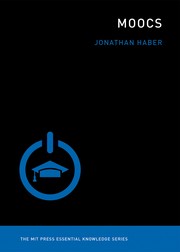
Jonathan Haber, MOOCS. The MIT Press Essential Knowledge Series. Cambridge, Mass. : The MIT Press, 2014.
I read Jonathan Haber’s book MOOCs a few months ago, and am glad to finally offer some thoughts. Despite a remarkable cooling of interest in MOOCs, there are still plenty of reasons to consider what role they might play in higher education. Haber, perhaps best known for his year-long MOOC experiment to obtain the equivalent of a bachelor’s degree, here offers a readable and balanced account of the MOOC environment.
Haber begins by outlining the history of MOOCs (massive open online courses), pointing out that “open” was an earlier driver than “massive” with MIT’s OpenCourseWare initiative for class materials (begun in 2002), though many of those courses lack video lectures. The first real MOOC came along in 2008, “Connectivism and Connective Knowledge,” taught by Stephen Downes and George Siemens. In the connectivist model, class size became an asset, not a liability (p. 39):
For the bigger the connectivist “class,” the greater the potential for the quantity and variety of nodal connections that define success for networked learning.
However, as MOOCs evolved, most were not designed around a specific pedagogical method, and Haber notes how different the learning experience is between connectivist and non-connectivist MOOCs. A tool for student connection common to both models is the discussion board, though they can be overwhelming to students, resulting in low participation rates. Scheduled vs. on-demand MOOCs have different types of discussion, with the latter focusing more on test and assignment support rather than on general course topics. Haber provides an interesting analysis of other ways that scheduled and on-demand MOOCs differ (p. 78-79).
In his chapter Issues and Controversies (p. 89-131), Haber first focuses on the low completion rates of MOOCs (a problem shared by a MOOC I wrote about last year). He argues that MOOC sign-ups are due mostly to curiosity rather than commitment. Still, though completion rates may be low, the raw completion numbers are still very large, and Haber quotes a professor who remarks that the number of students completing his MOOC is equal to all of the students he has taught in his career up to that point. Problems such as course demand level, cheating, plagiarism, and student identity are being addressed in a variety of ways, such as Coursera’s signature track identity verification.
On the positive side, there’s evidence that the shorter lectures used in most MOOCs are more effective, and that the ability to change speed, pause, and repeat lectures has a pedagogical impact. The interaction of older and younger learners common in MOOCs is rare in traditional education. The modularity of MOOCs is increasingly being utilized, and MOOCs have been successful in blended learning, rather than as a substitute for the classroom. Indeed, edX material is used at MIT to flip courses, and there’s extensive discussion about how MOOCs can fit into the flipped classroom model (p. 156-161). On the whole, MOOCs have raised the bar for online education in terms of production value, creativity, and risk-taking.
In these days of corporate open-washing, anything claiming to be open bears further examination. Haber notes that “open” tends to be interpreted by the public as “free,” despite the need in some MOOCs to purchase materials in order for the student to benefit the most from the course. Haber offers solid discussions of intellectual property (beginning on p. 118) and openness (beginning p. 122). A central problem has been that academic libraries license content for their campuses which cannot legally be shared with large numbers of unaffiliated students. Additionally, educational use is not automatically fair use (a common misunderstanding). Options for using external material include a full fair use analysis, obtaining permission (often at a cost), linking to content, and/or using openly licensed resources. And of course, most MOOCs are not openly licensed themselves. However, edX seems to be upholding open values and thriving, according to a recent article.
Haber also covers the difficulties involved in getting credit for MOOC courses from institutions of higher learning through programs like high school Advanced Placement (AP), the College Board’s College Level Examination Program (CLEP), and the American Council of Education’s (ACE) CREDIT program, which accredits courses for college-level equivalency. Publicity and incentives for the one-off alternative credit are not sufficient, which may explain why there were no sign-ups for either an ACE transcript for a MOOC or a Udacity-Colorado State course in computer programming (p. 106). Yet the future of MOOCs for younger learners, Haber says, may be alongside these existing programs.
This book introduced me to Straighterline and the SPOC (small private online course- for example, CopyrightX, which I hope to take), but the MOOC environment is apparently so fast-moving that some interesting initiatives are now defunct, such as MOOCs Forum, MOOC Campus and mooc.org. Haber perhaps overstates the altruistic purposes of MOOCs (p. 187), and his statements about the cost challenge of MOOCs to residential education may be premature.
MOOCs is part of the MIT Press Essential Knowledge series, which notably includes Peter Suber’s Open Access and John Palfrey’s Intellectual Property Strategy (which I reviewed previously). In addition to an index and notes, it includes a glossary, additional resources, and a list of MOOC providers. It’s an enjoyable and informative read, though not one inspiring certainty, perhaps best communicated by one last heavily-qualified quote (p. 194):
But if MOOCs continue to embrace-or even expand on- the culture of experimentation and innovation that has already set them apart from nearly all other adventures in technology-based learning, if they continue to offer high-quality free teaching to the world while also serving as the laboratory where educational innovation thrives, then whatever MOOCs are today or whatever they evolve into, they are likely to leave an important mark on whatever ends up being called higher education in the future.



